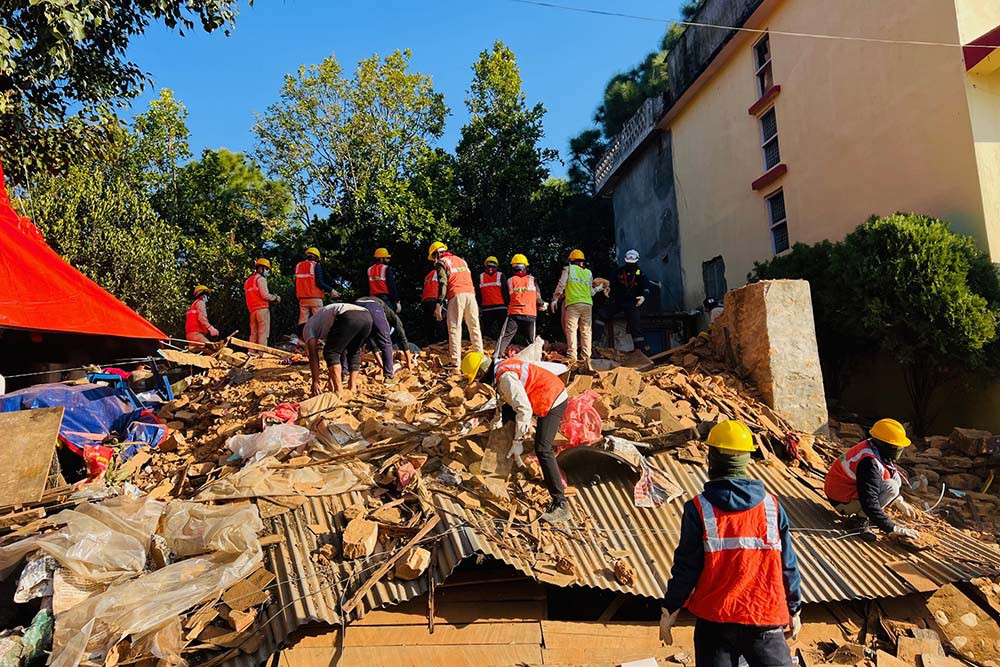
Nepal which was battered by acute shortage of power for the last decade is on track of energy sufficiency within a year. Major hydropower projects that are under construction are to generate electricity within this period. At present the total installed capacity of domestic power plants stands at just above 1000MW and within a year the capacity will be doubled if the power plants that are under construction do not face major glitches.
Out of 1000MW that will be added to the national grid within a year, three projects owned by Nepal Electricity Authority (NEA), the state-owned power utility, will contribute more than 500MW and the rest will come from privately owned hydropower projects.
The 456MW Upper Tamakoshi, 60MW Upper Trishuli 3A and 14MW Kulekhani-3 are hydropower projects owned by the power utility. Similarly, around two dozen hydropower projects are being developed by independent power producers to contribute around 500MW of electricity, according to Independent Power Producers’ Association of Nepal (IPPAN).
Considering the current demand of 1300MW during peak hours, the country is all set to have surplus energy within a year at least during the wet season when hydropower power plants generate electricity at full capacity. However, during the dry season when water levels in the major river basins go down, electricity generation by domestic hydropower plants drops by more than 50% making it difficult to meet demand.
Almost all hydropower projects except Kulekhani-1 and Kulekhani-2 are run of the river type of plants meaning their electricity generation varies according to water levels in the river basins where the projects are located. If the water level goes up, electricity generation goes up and vice versa.
At present, the total electricity production by domestic hydropower plants stands at around 500MW which is just half of its installed capacity. In some power plants, it has gone down by almost 60% of the installed capacity. As a result, NEA is importing around 500MW of power from India from more than a dozen cross-border transmission lines to meet national demand.
This characteristic is what leads to the condition of energy surplus during the wet season and lowered capacity in the dry season. According to NEA officials, even if the current installed capacity doubles within a year, the supply might not be enough to meet the demand during the dry season.
The solution according to the NEA Managing Director Kulman Ghising is electricity trading with neighbouring countries, especially India. If the country sells surplus energy to neighbouring India during the wet season when generation is high and buys it back during the dry season when demand is higher than the supply, the problem will be resolved. The difference in nature of electricity demand in both countries also favours the situation. During the rainy season when there is surplus electricity in Nepal, there is high demand for electricity in India due to high agricultural demand. Likewise, the demand for electricity during winter is less in India while the demand in Nepal is higher than the supply.
If both the countries treat electricity as a commodity and allow non-discriminatory access to cross-border interconnection to all the licensed participants as mentioned in power trade agreement (PTA) signed between Nepal and India in 2014, the situation of fluctuating supply of electricity will be addressed.
However, the guidelines on cross-border power trade issued by the Indian Power Ministry in December 2016 prohibit private and third country hydropower developers in Nepal from exporting electricity to India with one-time approval. According to the guidelines, only companies in Nepal which are wholly owned by Indian government or the public sector or private companies with 51% or higher Indian stake would be eligible to export power. These companies will be allowed to sell power to India after getting one-time approval. The companies owned by Nepal government will also be allowed to sell power to India with one-time approval. But, private companies of Nepal owned by domestic or foreign developers have to obtain approval on case-to-case basis. This has discouraged many foreign developers who wish to develop hydropower projects in Nepal eying the Indian market.
Although the joint statement released during Indian Prime Minister Narendra Modi’s recent visit to Nepal said both countries agreed to enhance bilateral cooperation in power sector in line with the PTA, no headway has been made yet. Apart from the guidelines on electricity trade issued by the Indian government, the difference in price of electricity will also act as a barrier. The per unit cost of electricity is way cheaper than in India. While Rs 4.80 per unit is the cheapest rate offered by domestic power plants in Nepal, electricity is being traded in India at less than Rs 4 per unit. As the price of electricity is lower in India, it will make the electricity from Nepal less competitive in the Indian market creating a major barrier to electricity trade between the two countries.
The appropriate way to kick start electricity trade with India, as put forth by NEA, could be energy banking between the two countries. Energy banking refers to exchange of electricity for the electricity instead of cash. Under such mechanism, Nepal exports electricity to India when it has surplus while it imports back the same amount of energy when it has a deficit.
According to NEA, the fluctuating demand of electricity in India and fluctuating supply in Nepal makes energy banking between the two countries a highly suitable model for power cooperation to benefit both the countries. The NEA has already submitted a concept note of the model to the Indian embassy in Nepal to forward it to the Indian power ministry.
Both the countries have agreed to discuss the mechanism during the energy secretary-level joint steering committee meeting slated to be held in a few months. If the southern neighbour agrees to the barter arrangement as proposed by Nepal, surplus electricity can be exported to India during the wet season while the same volume will be imported back during the dry season when there is shortage of energy. “Considering the characteristic of domestic hydropower plants, energy banking would be the best way to attain energy self-sufficiency as it manages energy spill during the wet season while arranges extra supply during shortage,” said Ghising.
Another issue the power utility must address for energy-sufficiency is improvement of the distribution network which is very poor at present. Although NEA has eliminated power cuts from individual residences for more than a year and recently from the industrial corridor, there have been abrupt power cuts for short periods of time due to poor distribution networks. The existing distribution network is so fragile that major cities of the country with high demand for electricity are witnessing regular tripping. If the distribution network is not strengthened, it is impossible to meet the demand of electricity despite adequate supply.
NEA Chief Ghising agrees that the existing distribution system is fragile and needs immediate improvement. The distribution network in the Kathmandu Valley is most critical as it will be unable to handle additional supply in the near future. Speaking at a talk programme in Kathmandu recently, Ghising said the NEA must take immediate measures to improve distribution in the valley. The existing system can’t support more than 400MW of load, according to NEA. As Kathmandu’s demand will soon exceed 400MW, the upgradation is an immediate necessity.
If the distribution system is not improved, the power utility has to impose power cuts even if there is enough supply of electricity. To be fair on Ghising, under his leadership, the NEA is planning to upgrade the valley’s distribution system to be able to support the supply of up to 2000MW of electricity by upgrading the existing sub-stations, building new ones and laying underground electric cables to replace overhead ones. The power utility is carrying out the upgradation with $180 million Power Transmission and Distribution Efficiency Project which is funded jointly by Nepal government and the Asian Development Bank. While it has already appointed contractors to construct half-a-dozen substations in the Kathmandu valley and nearby locations, NEA is in the process of selecting contractors to replace overhead wires with underground cables in key places in the valley.





